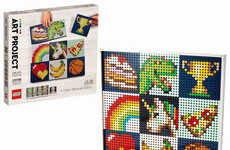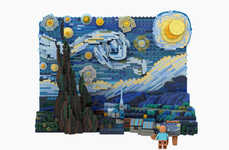
Brooklyn Studio & Steve Mayes Debut Brooklyn's Architectural History
References: brooklyn.studio & design-milk
The architectural firm The Brooklyn Studio and the independent LEGO artists Steve Mayes have debuted an interesting, limited edition LEGO set that visually recreates Brooklyn's architectural history. Without a doubt, such a creative direction is niche and will pique the curiosity of locals, urbanists, architects, and designers.
The special edition LEGO set includes important landmarks for Brooklyn's architectural history—from the Carroll Street Bridge and the Bridge Tender’s House (both of which were completed in 1889) to the Memorial Arch (1892) and Prospect Park (1873). In total, The Brooklyn Studio x Steve Mayes LEGO set consists of 349 pieces.
For The Brooklyn Studio, which specializes in rowhouse architecture, the LEGO collaboration is "arguably aligned with their ability to capture the Brooklyn streetscape as a simplified brick-by-brick recreation."
Image Credit: The Brooklyn Studio
The special edition LEGO set includes important landmarks for Brooklyn's architectural history—from the Carroll Street Bridge and the Bridge Tender’s House (both of which were completed in 1889) to the Memorial Arch (1892) and Prospect Park (1873). In total, The Brooklyn Studio x Steve Mayes LEGO set consists of 349 pieces.
For The Brooklyn Studio, which specializes in rowhouse architecture, the LEGO collaboration is "arguably aligned with their ability to capture the Brooklyn streetscape as a simplified brick-by-brick recreation."
Image Credit: The Brooklyn Studio
Trend Themes
1. Architecture-inspired LEGO Sets - The creation of LEGO sets based on architectural themes provides an opportunity for architects and designers to capture historical landmarks in a creative way.
2. Limited Edition LEGO Collaborations - Partnering with independent LEGO artists can create niche products that appeal to specific audiences such as urbanists, history buffs, and architects.
3. Simplified Brick-by-brick Recreation - Using LEGO as a medium to capture complex architecture can provide a simplified and accessible way for people to appreciate and understand historical landmarks.
Industry Implications
1. Architecture and Design - Using LEGO sets as a medium can allow architects and designers to showcase their work in creative ways and potentially attract new clients.
2. Toy Manufacturing - Partnering with independent artists to create unique and limited edition LEGO sets provides an opportunity for toy manufacturers to tap into niche markets.
3. Tourism and Education - Creating LEGO sets based on historical landmarks can provide a fun and interactive way for tourists and students to learn about the history and architecture of specific regions.
4.7
Score
Popularity
Activity
Freshness























